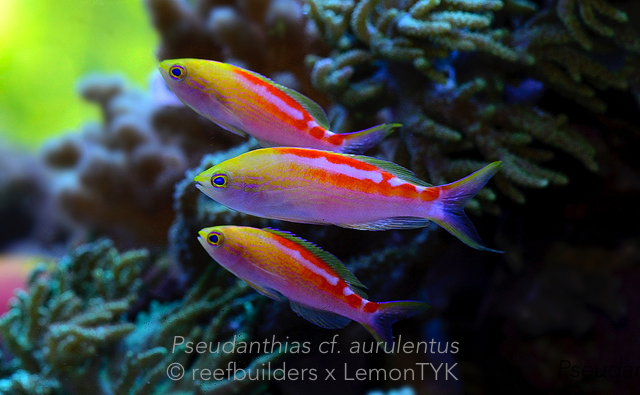A few days ago we wrote about a potentially new Pseudanthias species from Cairns Marine that has been coming out of the Coral Sea. This remarkable fish has been dubbed temporarily as Pseudanthias cf. aurulentus and is a member of the Pseudanthias lori complex. In our earlier article, we uploaded some photos of the fish taken in a photography tank with a dark background. If you thought that they looked pretty then, check them out now all nicely settled down in a reef environment.

Like most other members of the “lori complex“, these fish are fond of deeper water and are collected in excess of 60m (200ft). Ideally they should be kept in an aquarium with dim lighting to simulate their natural habitat. Because these aren’t in the strictest sense deepwater specialists, they can, like many species slowly adapt to brighter reef conditions gradually. The trio you see here are kept in a pretty standard reef tank with metal halides, which have been turned off and illuminated weakly with T5 bulbs for the next week or so. Photoperiod has also been reduced to a few hours a day. We don’t have any SPS corals in this tank, so coral wise nothing drastic should happen.
Pseudanthias are very social and active fish that are usually found in large groups in the wild, often in mixed species groups. The trio here shares a tank with Pseudanthias flavicauda, and can be seen interacting together especially during feeding where both species pick food aggressively from the water column.
We’ve taken some more photos of the fish in a nice comfortable reef setting and they’re looking absolutely stunning. We’ve attached a small gallery above for your viewing pleasure. Pay special attention to the patterning of this fish, and notice how it has traits of both P. aurulentus as well as P. privitera.
 In our previous article, the phylogeny of Pseudanthias cf. aurulentus was brought to our attention by Joe (user: Joe Fish). The cladogram above is a hypothesis of Joe’s regarding the phylogeny of Microlabrichthys, and where each individual species sits. It may not be 100% accurate, but it’s good enough to provide us a rough idea on the cladistics.
In our previous article, the phylogeny of Pseudanthias cf. aurulentus was brought to our attention by Joe (user: Joe Fish). The cladogram above is a hypothesis of Joe’s regarding the phylogeny of Microlabrichthys, and where each individual species sits. It may not be 100% accurate, but it’s good enough to provide us a rough idea on the cladistics.
You can see that even within the “lori complex“, there are clades of distinct classifications, with P. aurulentus and P. privitera sharing the same branch, being basal to the Coral Sea P. cf. aurulentus. P. flavoguttatus and P. sp. “sunrise” also share a branch, and all of these under the common ancestor of P. lori. Although this may only be a rough idea, it’s good to keep this in mind until the official description of the Coral Sea P. cf. aurulentus is released, to see exactly how accurate this hypothesis is.

Incase you’re still not convinced that these guys may potentially turn out to be new, here are two photos from Cairns Marine posted last year in April 24th and June 26th respectively. Yeah surprise! They’ve been around for awhile now, but the limited number and high demand meant that we didn’t get to examine them closely for ourselves until now.
Based on the top down shots and the group photo on the left, its pretty clear that the markings are notedly different from any closely related species we know of, and to top it off, they are very consistent. Notice how the white stripe is “toothed” at the rear in some specimens, indicating resemblance toward P. aurulentus. The stripe however is thinner than the latter, and the head region is very yellow which points to P. privitera.
These are preliminary findings that often point to a new species, and now that investigation is underway, we can’t wait to hear what comes out of this.



